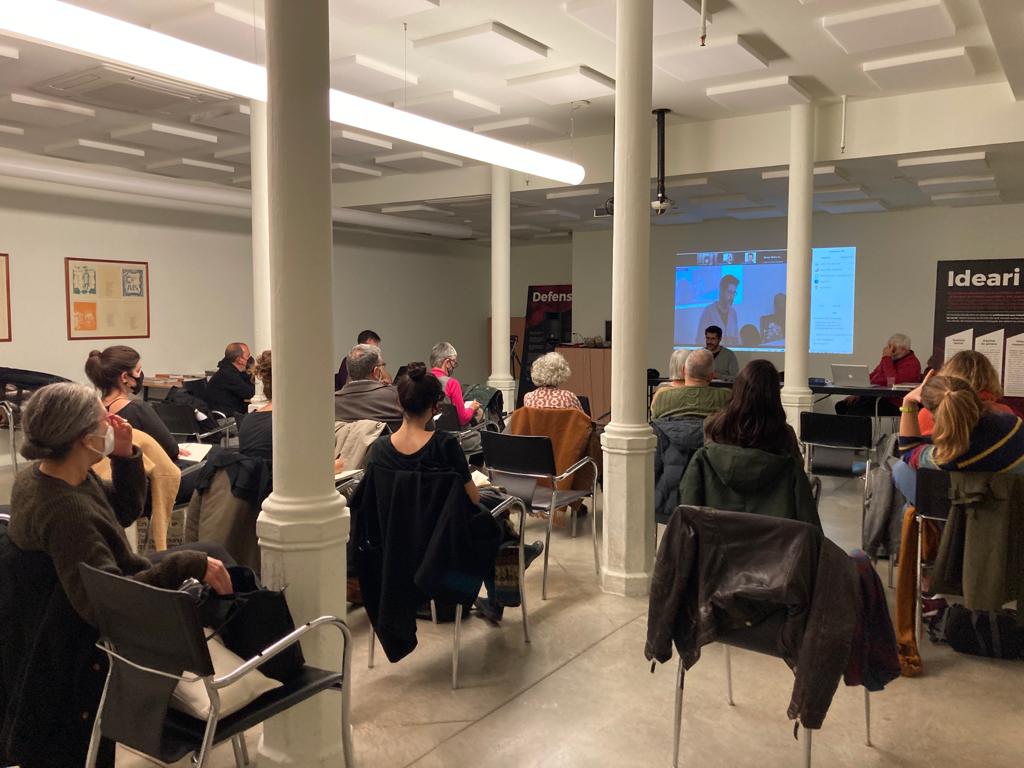
Yesterday we celebrated for the fourth consecutive year our debate around architecture as a tool for social transformation, an activity that has already established itself as an annual event in which we reflect more theoretically on the imprint of practice architecture in its social and environmental environment.
On this occasion, we wanted to meet others ways to access and design adapted housing or with services by the elderly or by people with functional diversity, beyond the logic of the market and individual property. This is a very relevant topic in our cooperative, as we currently have two senior projects in development (Walden XXI i Can 70), as well as different seed groups working on it. However, we have generated several tools and resources to support these types of initiatives, such as the guide "Care in the coexistence of elderly people".
The event took place in the Aula Ronda, given by the Col·lectiu Ronda, with nearly 40 attendees in person, and another 40 connected to follow the event online. On this occasion, we had international participation, with the intervention of the Linda Björn, architect and founding partner of the Marge Arkitekter team, from Sweden. They accompanied her Maider Azurmendi, social worker and head of community cooperation at the Matia Institute (Euskadi); and the Chatxo Shoemaker, Doctor of Architecture, professor and researcher at the Vallès School of Architecture (UPC).
Architecture and salutogenic model
Linda Björn opened the presentations explaining the projects and learnings of the team from Marge Arkitekter, a studio that has been building homes for the elderly for ten years. Their work starts from a salutogenic point of view, with the aim of making the lives of the people who live in their buildings better by combating their main problem: loneliness.
Therefore, their projects are created to bring quality to the senses and always put the users at the center: the elderly and the professionals who attend to them, but also the relatives of the elderly. Some examples of elements they incorporate are accessible kitchens, so that people can participate in everyday activities, or work with colors and patterns that allow the elderly to orient themselves more easily and recognize the place.
"When a person cannot go out to be part of the community, the community must enter the building"
Linda Björn
In addition, the architect explained how her buildings are designed to carry out activities with people and groups from the environment, with common areas facing outwards, and how the possibility of movement and autonomy is prioritized: to invite and facilitate for people to walk, a pleasant and accessible environment must be created, with views to the outside and rest areas that can be impromptu meeting spaces.
"Homes for life"
Next, Maider Azurmendi intervened to explain the project "Homes for life", from the Matia Foundation, an institution with more than 130 years of history offering socio-health care in Guipúzcoa to accompany people in their aging, from autonomy and care centered on the person.
The project is located in the municipality of Lugaritz and it is expected that it can be inhabited by the spring of 2023. "Viviendas para toda la vida" is designed for those elderly people who already have someone to take care of them (be it a family member or a professional), to generate a familiar and protective environment where they can continue to be cared for.
These are 51 homes, with 2 and 3 bedrooms, to guarantee separate rooms for the dependent person and the carer, the latter with an independent door to also ensure the autonomy of the person accompanying them. In addition, along the lines of Linda Björn's explanation, meeting spaces are encouraged in the passage areas, and they count on having several shared spaces, such as the dining room and kitchen.
Residential architecture, key to care
Finally, Txatxo Sabater presented the perspectives of housing with services in accordance with an exhaustive study on "gerohabitation, cohabitation and emancipation" drawn up by the Provincial Council of Barcelona.
With the presentation of an interesting historical review of building proposals designed to meet the needs of dependent people, it became clear that residential architecture can be key to facilitating the care of the people who live there. Housing cannot be thought of by independent people, you never know when we will stop being independent.
One of the examples given by Sabater are the Sakura apartments, by the architect Hitoshi Wakamatsu, a proposal that consists of dividing each home into a main one and a secondary one, for the different stages and needs throughout life . In this way, two related coexistence units can live together, but maintaining their independence: elderly people close to their family, teenagers who are getting older, two families who live together... etc.
"The best way to guarantee the independence of the elderly is through interdependence."
Chatxo Shoemaker
To finish, the Doctor and architect reflected on the margin that exists between care being the responsibility of the family or the institution. A space that fills the senior cohousing as an alternative, as it allows autonomy and independence for the person, but also favors community moments.
You can retrieve the video chat here:
And if you are interested in this debate, we recommend you also review the previous editions:
- 2020: Community participation and co-design in residential architecture
- 2019: Cooperative housing: sustainability vs. affordability
- 2018: Architecture as a tool for social transformation
This activity is carried out with the support of Barcelona City Council, and is part of the "Architecture as a tool for social transformation" project

 Twitter
Twitter Facebook
Facebook Youtube
Youtube Instagram
Instagram
